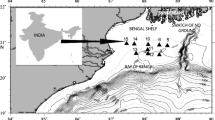Abstract
Grain size and geochemical analyses have been carried out on 58 samples collected from different areas of mangrove environment of the Egyptian Red Sea coast. The texture characteristics of mangrove sediments show that the mean size decreases in sediments of coastal areas while increase in island sediments and the sediment type generally changes from sand to slightly gravelly muddy sand. The sediments are composed mainly of poorly sorted, negatively nearly symmetrical and leptokurtic fine sands. Cluster analysis showed that, distribution of gravel, sand and mud fractions is related to bottom facies and type of sediment source. Generally, sand fraction is the main category among the three constituents. Geochemically the factor controlling the carbonate content of studied sediments includes material supply of biogenic and terrigenous components. Therefore, sediments of Hamata area, km 17 south Safaga, Wadi El-Gemal Island and Abu-Minqar Island are terrigenous sediments, while sediments of km 37 north Quseir are highly carbonates. In general organic matter is higher in the mangrove sediments relative to adjacent areas. The high organic matter in the mangrove sediments is primarily due to the high supply from primary productivity, terrestrial and reworked sediments. Texture is the main controlling factor for the organic matter enrichment. Spatial variations in the phosphorus content in the different studied localities are related to the sources of phosphorus to the area. In comparison, cluster analysis indicates that phosphorus might be transported from terrestrial source to the sea through wadis draining the excavated Upper Cretaceous phosphate rocks. Also, the abundance of phosphorus content may be attributed to phosphatization of calcareous skeletons. Our observations provide knowledge on the physico-chemical effects and will be useful in the management and suitable development of the areas under study. In addition it represent database in the future.





Similar content being viewed by others
References
APHA (1995) Standard methods for the examination of water and wastewater, 25 edn. American Public Health Association, American Water works Association, Water Env. Federation, Washington, DC, 1200 p
Cintron G, Schaeffer-Novelli Y (1983) Mangrove forests: ecology and response to natural and man induced stresses. In: Ogden JC, Glatfelter EH (eds) Coral reefs seagrass beds and mangroves: their interactions in the coastal zones of the Caribbean, pp 87–113. UNESCO 23
Dean WE Jr (1974) Determination of carbonate and organic matter in calcareous sediments and sedimentary rocks by loss in ignition: comparison with other methods. J Sediment Petrol 44:242–248
Dicks B (1984) Oil pollution in the Red Sea—environmental monitoring of an oilfield in a coral area, Gulf of Suez. Deep Sea Res 31A:833–854
El-Askary MA, Nasr SM, Moussa AA, El-Mamony MH (1988) Geochemical approach to the beach and bottom sediments of the Jubal area at the entrance of the Gulf of Suez. Bull Inst Oceanogr Fish ARE 14/1:105–121
El-Mamoney MH (1986) Studies on the beach and offshore sediments of Jubal strait area at the entrance of Gulf of Suez. MSc Thesis, Alexandria University of Egypt, 126 p
El-Sayed M Kh (1974) Littoral and shallow water deposits along the Mediterranean coast of Egypt, off Alexandria. MSc Thesis, Faculty of Science, Alexandria University, 150 p
Evenari M, Gutterman Y, Gavish E (1985) Botanical studies on coastal salinas and sabkhas of the Sinai: In: Friedman GM, Krumbein WE (eds) Hypersaline ecosystems, the Gavish Sabakha. Springer, Berlin, Heidelberg, New York, Tokyo, pp 480
Ferrar HT (1914) Notes pn a mangrove swamp at the mouth of the Gulf of Suez. Cairo Sci J 8:23–24
Folk RL (1980) Petrology of sedimentary rocks. Hemphill Publishing Co., Texas, pp 182
Folk RL, Ward WC (1957) Brazos River bar: a study in the significance of grain size. J Sediment Petrol 27/1:3–26
Kairo JG, Hegazy AK (2003) Rehabilitation, conservation and sustainable utilization of mangroves in Egypt. TCP/EGY/0168(A)
Madkour HA (2004) Geochemical and environmental studies of recent marine sediments and some invertebrates of the Red Sea, Egypt. PhD Thesis, South Valley University of Qena, pp 317
Malecki G (1986) SEDPAK—Charakterisierung Von Sedimenten aufgrund der Korngr. Analyse Ber Geol B-A, Blg. 12, Wien
Mansour AM (1992) Sedimentological investigations of mangrove environment along the western coast of the Red Sea, Egypt. Asw Sci Tech Bull 13:154–176
Mansour AM (1999) Changes of sediment nature by environmental impacts of Sharm Abu Makhadeg area, Red Sea, Egypt. Sedimentol Egypt 7:25–36
Mansour AM (2003) Pressures and impact of coastal zone of Abu Minqar and Giftun Islands, Hurghada, Red Sea, Egypt: a management priority. In: 5th International conference on the geology of the middle east, Ain Shams University, Cairo, Egypt, pp 417–430
Mansour AM, Nawar AH, Mohamed AM (1997) Recent intertidal sediments and negative impact of human activities, Red Sea coast, Egypt. Egypt J Geol 41/2A:239–272
Mansour AM, Nawar AH, Mohamed AW (2000) Geochemistry of coastal marine sediments and their contaminant metals, Red Sea, Egypt: a legacy for the future and a tracer to modern sediment dynamics. Sedimentol Egypt 8:231–242
Odum WE, Johannes RE (1975) The response of mangrove to man—induced environmental stress. In: Ferguson Wood EJ, Johannes RE (eds) Tropical marine pollution, Elsevier, Amsterdam, pp 52–62
Reiss Z, Hottinger L (1984) The Gulf of Aqaba. In: Ecological micropaleontology III. Springer, Heidelberg, pp 354
Riley JP, Skirrow G (1965) Chemical oceanography. Academic, London, New York, pp 508
Saenger P, Hegerl EJ, Davie JdS (1983) Global status of mangrove ecosystems. Commission on ecology paper no 3. IUCN, Switzerland, pp 80
Zahran MA (1965) Distribution of the mangrove vegetation in U.A.R. Egypt. Bull Inst Deserte d’Egypte 6–11
Zaharn MA (1967) On the ecology of the east coast of the Gulf of Suez. 1. Littoral salt marsh. Bull Inst Desert Egypt 17:225–251
Zahran MA (1974) Biogeography of mangrove vegetation along the Red Sea coasts. In: Proceedings of international symposium on biology and management of mangroves, East-West Center Honololo, Hawai, pp 43–51
Author information
Authors and Affiliations
Corresponding author
Rights and permissions
About this article
Cite this article
Madkour, H.A., Mohammed, A.W. Nature and geochemistry of surface sediments of the mangrove environment along the Egyptian Red Sea coast. Environ Geol 54, 257–267 (2008). https://doi.org/10.1007/s00254-007-0813-8
Received:
Accepted:
Published:
Issue Date:
DOI: https://doi.org/10.1007/s00254-007-0813-8




